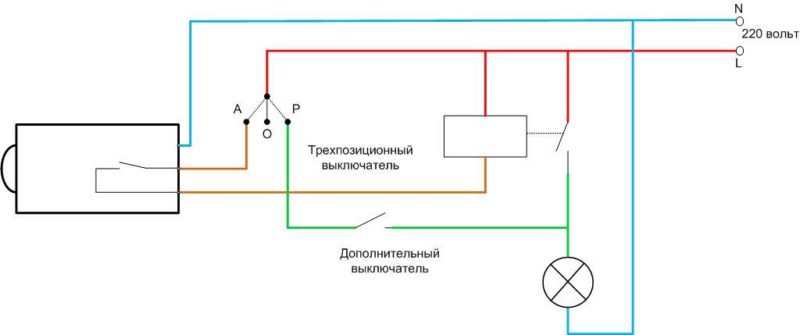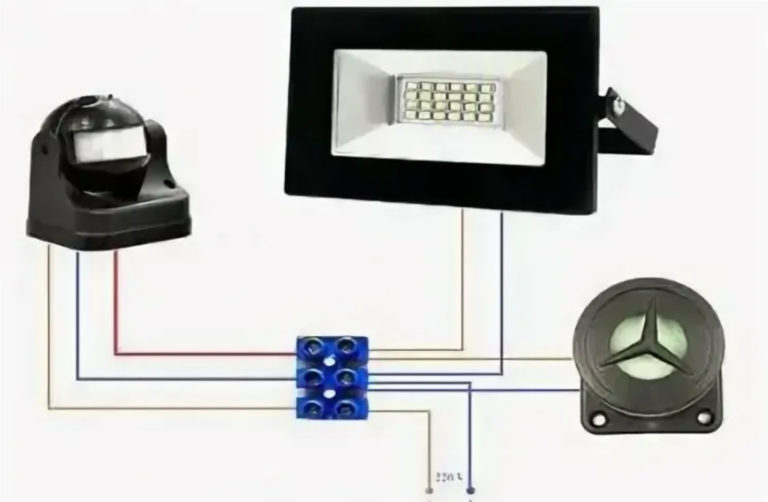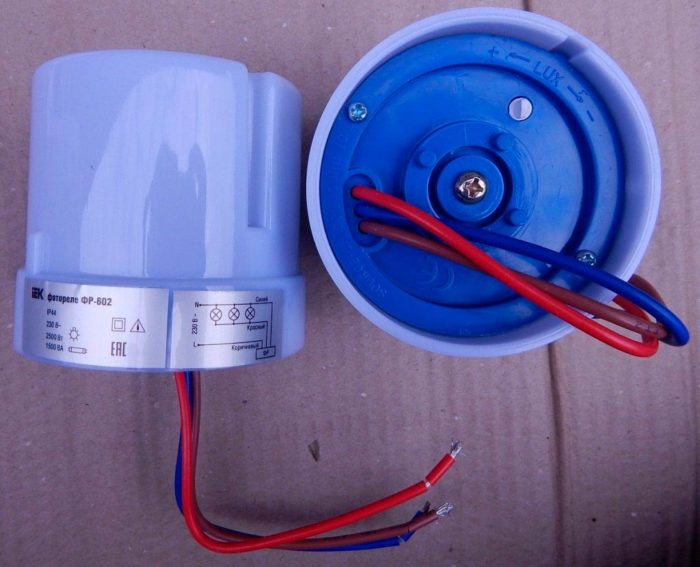Wiring diagram of a light sensor
For automatic control of exterior (and sometimes interior) lighting, it is convenient to use a photo relay. If the natural light level decreases in the evening, it will turn on the artificial lighting system and turn it off in the morning when the sun rises. If you combine the photocell with a motion sensor, you can get even greater savings - the light is turned on only at night and only if a person is present. There are many such combined models on sale. You can choose and connect a day/night sensor by yourself.
What is a photo light barrier, its construction and principle of operation
If we consider the photo relay as a "black box", its structure and principle of operation are simple:
- on the input side is a sensitive element, where the light hits;
- on the output side - a signaling device;
- on the body - the adjusting body.
When light hits (or stops hitting) the sensitive sensor, the device outputs a signal that can be used to control actuators, lights (directly or through a repeater relay).

You can give a signal to the control panel or initiate an alarm system. The signal can be in the form of:
- voltage level change (logic level);
- "dry contact" of the relay;
- change of electronic switch status (transistor with open collector), etc.
The light detector can be built into the device body, or it can be remote. Then it can be installed in any convenient place. The adjustment unit allows you to adjust the triggering level - you can make the relay turn on the light earlier or later.
In fact, the structure of the photo relay is more complicated.

In general the device contains:
- element sensitive to light (photoresistor, photodiode, etc.);
- conversion device (converts a change in the state of the sensor into a change in the electrical voltage);
- amplifier-buffer;
- threshold device - compares the voltage from the sensor with the set level;
- timer - limits the operating time of lighting;
- Formator of output signal.
Devices from different manufacturers have different circuitry. Some elements may be combined, some may be missing. Some devices have a fixed level of operation, they have no adjustment body.
Important! Photocells are often called a light sensor, light sensor, day-night sensor, etc. Such names are not quite correct. Strictly speaking, the light sensor is a part of the light sensor that converts the light level into an electrical signal or a value that can be converted into an electrical signal.
Important technical parameters and varieties
Before selecting the photoelectric relay, it should be clear where it will be installed and what load it will control. With this in mind, you should pay attention to the following specifications when buying.
- Supply voltage. Can be AC 220 volts or low DC (12, 24 volts, etc.). It is selected from the convenience of connection at the place of installation.
- Sensor design. The light detector is either remote or built-in. Remote can be mounted a few tens of meters from the main unit.
- Protection level. Determines the place of installation. If, for example, the device has a degree of protection IP20, this implies installation only indoors (in the switchboard) and a remote sensor.
- Load capacity. Determines the electrical power that can be directly switched by the photoelectric relay.
- Switching threshold range .. Specified in lux. It is not particularly useful information, because it is difficult to determine by eye what level of activation is needed in the field. The wider the range, the better.
- Delay on or off. From zero to several tens of seconds is enough for all occasions.
- Also among the parameters is the intrinsic consumption of the device. It is small, in most cases not more than 5-6 watts. Therefore, there is no point in chasing this parameter.
| Light barrier relay | Load capacity of the contact group |
| FR-2M | 16 A (220 VAC, 30 VDC) |
| FR-1 | 6 A (380 VAC) |
| FR-601 | 10 A (220 VAC) |
| FR-602 | 20 A (220 VAC) |
| FR-M02 | 16 A (220 VAC) |
Based on these characteristics you can choose the relay with the best combination of technical and price parameters.
Wiring diagram of the light sensor
Wiring diagram of the light sensor is not complicated. In fact, it is a light switch, and it should be connected according to the same principle. But the photocells have peculiarities that can pose certain challenges during installation.
Connection in TN-C and TN-S networks
Currently in Russia, 220 volt networks are in operation, in which the protective (PE) and neutral (N) conductors can be combined (TN-C) or separated (TN-S). The TN-S system is considered more progressive and correct, but a complete switchover is still a long way off.
Photocouplers in a TN-C two-wire network

The difference to a normal light switch is that the photocell must have a neutral conductor connected. This is necessary to supply power to the internal control circuitry of the photoelectric sensor. If the sensor supply voltage is different from 220 volts, it does not need to be connected to the neutral wire, but it will need an external source of zero voltage.
Photocoupler in a TN-S three-wire network
In a TN-S network there is an additional PE wire. The design of almost all photocells does not provide connection of this conductor, so the scheme will not change.

Connection of the light sensor through a repeater relay
In some cases, the load capacity of the light sensor's own contact group may not be enough to switch the available load. In this situation, the output of the device should be strengthened by an intermediate relay whose function can be performed by a magnetic starter. Its contacts must be designed for the full current of the lighting device. The output of the light relay should be connected to the winding of the starter. And the contacts of the repeater relay will switch the light bulb power.

Scheme of inverting output signal
There are situations where you need to control a lighting device by the inverse principle - turn on when there is natural light and turn off when the sun goes down. Such a photo relay-repeater may be needed, for example, when working in the lighting system of rooms without windows (for keeping cattle, etc.). It is not difficult to implement, the wiring diagram of the light sensor is almost the same as the previous one. Only a starter with a change-over contact group is needed.

If there is no signal from the light sensor, the lamp is energized through the normally closed (NC) contacts of the repeater. If the relay is triggered by the light, the starter will energize the bulb. When darkness falls, the light will turn off.
Supplementary circuit with an auxiliary switch
An additional switch can be added to the standard arrangement. This allows the lighting to be switched on and off independently of the light barrier, depending on the selected option. This might be necessary if the light's light barrier is out of order.


If a repeater relay is used in this variant, the additional switch must be put parallel to its contacts. It is even better to supplement the circuit with a three-position switch. It will help to select the mode of lighting - manual or automatic. A complete wiring diagram will look like this.

Mode O allows you to take the lighting completely out of operation.
Installation and mounting of photocells
First of all, it is necessary to determine the place of installation of the light-sensitive sensor. To do this, it is necessary to observe a few simple rules.
- Do not install the photo sensor where it can be exposed to light from artificial sources (street lights, headlights of passing cars, etc.). This will cause the lights to turn off. The worst option is when the photosensor is illuminated by the controlled lamp. You will get a feedback circuit: darkness - lighting turned on - light hit the photo sensor - lighting turned off, darkness - ... and so on in a circle. No comfort in this case can not talk about.
- You should not install sensors in the shade. In this case you will have early switching off and late switching on.
- Protect the sensor lens from dust and dirt and install the device in such a way that the sensor is not contaminated. If this is not possible, you should at least clean the input part of the detector regularly. Otherwise, the sensitivity of the device will decrease.
- If a relay with a remote sensor is used, the maximum installation range should not be exceeded.
At the end of the video: Installing the photo relay for night lighting.
The electrical circuits must be installed with a cable with copper conductors. For mechanical strength considerations, select a cross-section of at least 2.5 mm² for outdoor wiring. In 99+ percent of cases, such a cable or wire will pass the maximum load conditions. Before you turn it on for the first time, you must carefully check the correct installation. After that, you can turn on the lighting system and start setting up.

